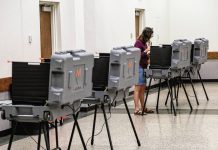The next phase of the State Street Revitalization Project will begin in May after the Columbus City Council approved spending up to $2.6 million to fund the renovation.
This phase of the revitalization project includes creating a trail link between the east side of Columbus and downtown and providing architectural elements along State Street, extending from the Hawcreek Bridge to Mapleton Street.
The project includes adding pedestrian streetscape improvements, including new 6-foot-wide sidewalks and ramps on the south side of State Street to Pence Street, and a new 8-foot paved trail on the north side of State Street to Indiana Avenue.
On Tuesday, the city council unanimously approved allowing the Columbus Redevelopment Commission to pay for the project with funds through the city’s Central Tax Increment Financing (TIF) District. The city’s ordinances require any expenditure of $500,000 or more to have council approval.
Redevelopment commission members approved spending the TIF funds on the project on March 20.
Heather Pope, city redevelopment director, presented a brief overview of the next part of the revitalization project, labeled Phase 2A, to council members, saying a contract is scheduled to be awarded April 25 for the work.
Although he voted to approve the spending, Councilman Frank Miller said he was concerned about the city seeking bids for Phase 2A before the council gave its approval. The Columbus Board of Works approved seeking bids on the Phase 2A project March 28.
Miller said he was not alleging any improprieties or illegal activity. But the appearance of the city seeking bids when council hadn’t approved funding sends a message to the public that it was a done deal, Miller said.
Columbus resident David Jones told the council he agreed with Miller.
“It looks bad,” Jones said. “We should be doing better at that process. If you’re not approving the money, then you don’t approve the project.”
City Attorney Alan Whitted said the city is on an aggressive schedule for the project. No activity takes place without funds being approved, he said.
After her presentation, Pope said the city decided to advertise bids for the upcoming phase to meet a specific timetable. Construction on Phase 2A is scheduled to begin May 2 with a targeted completion date of Nov. 1.
“It just worked out that way to try to get it done by the end of the year,” Pope said.
Miller said after the meeting that he had been alerted to the timing issue by constituents in his district.
[sc:pullout-title pullout-title=”State Street Revitalization Project Phase 2A” ][sc:pullout-text-begin]
Components of the State Street Revitalization Project (Phase 2A) include:
- New 6-foot-wide sidewalks and ramps on the south side of State Street to Pence Street, and a new 8-foot paved trail on the north side of State Street to Indiana Avenue.
- New public green spaces at Stadler Drive and at Indiana Avenue and State Street. The green spaces will feature trees, brick pavers and puzzle benches, with crosswalks being developed in conjunction with Ivy Tech Community College student designers.
- Features of a new pedestrian streetscape include new lighting and a sculptural red wave element along the path. Decorative crosswalks and brick curb ramps will also be developed as part of the second phase, which will include public art.
[sc:pullout-text-end][sc:pullout-title pullout-title=”What’s next” ][sc:pullout-text-begin]
After the Phase 2A work is bid out and completed, the city will begin considering Phase 2B, said Heather Pope, city redevelopment director.
The Phase 2B section will link the work on the east side of the Hawcreek Bridge to downtown Columbus and Mill Race Park through an urban trail. Streetscape improvements would occur between the bridge and California Street, and then connect to the urban trail on Fifth Street, from Lindsey to California streets.
The corridor improvements are designed to connect downtown Columbus seamlessly to the east side of the city through upgraded pedestrian trails and pathways and matching streetscapes that tie the two areas of the city together. The design is proposed to ease the transportation of people from eastern Columbus to downtown and vice versa, city officials said, with another goal being to generate more economic activity on the east side of the city.
[sc:pullout-text-end]




